My wife and I enjoy visiting the US National Parks. She enjoys photographing the outdoors, and the parks are a great place for that. And for me there are always birds. And as anyone who’s watched the Ken Burns’ documentary knows, the parks are just fantastic places.
When looking at a map of the parks across the country, it’s hard to avoid noticing the area of the Colorado Plateau, the region encompassing southern Utah, northern Arizona, and western Colorado. It stands out because there are seven national parks there, relatively close to each other. Proceeding counter-clockwise from the south, as we would be visiting them, they are Grand Canyon in Arizona; Mesa Verde in southwest Colorado; and Arches, Canyonlands, Capitol Reef, Bryce Canyon, and Zion in Utah. Collectively, this route is known as the Grand Circle.
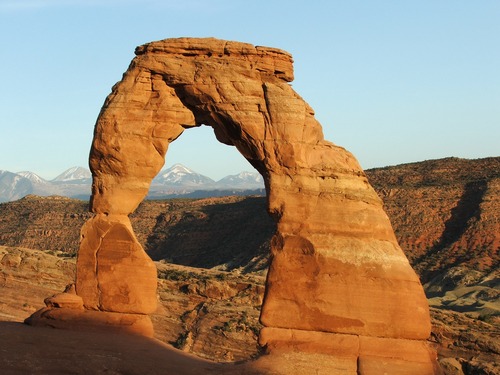
We chose to visit in the middle of May for a couple of reasons. Foremost is the fact that these parks receive many visitors during the summer after school lets out. We wanted to avoid that crush of people. Also, it appeared that the weather would be more in our favor. Some of these places get incredibly hot during the summer, and it looked like it would be much milder during this time. And it also happened to be right in the middle of migration.
Logistics
We flew in and out of Las Vegas, where we rented a car. The four-door sedan that we got had plenty of room for us and our luggage. And in no cases did we need a four-wheel drive or high-clearance vehicle. However, there were some more out-of-the-way places in this region where both would be required. But for this trip, we were not planning on going to them.
For the most part, we stayed at hotels close to the park entrances. Most of the parks have a “gateway community” that is relatively close by. We were able to find some good rates at the chain hotels (mostly Super8’s). At Zion, however, we had to move out to the town of Hurricane (23 miles from the park entrance) to find a good deal.
At the first National Park we came to, we purchased an inter-agency annual pass (the “America the Beautiful Pass”) that allows entry to all National Parks, along with some other places. It was $80, which was significantly less than what it would cost to pay for each park separately. If you make a trip like this, definitely consider this option.
The Birds
This region is not known for its avian diversity. But there are still some very cool birds here, not to mention some range and habitat-restricted species. For me personally, there was not an opportunity for a large number of lifers. Previous trips to the west had resulted in seeing most of the birds that we would encounter. Also, this was not a birding trip, per se. Our tight schedule meant that there was little opportunity to go out of our way just for birds. But the parks themselves offered a wide range of habitat and largely made up for this. Plus, like Yellowstone, these parks deserve to be visited regardless of the birds.
Birding Resources
Websites:
- Utah Birds
- Colorado Field Ornithologists: very nice website with directions to many birding locations
- Colorado Birding Society: also has directions to sites, and is regularly updated with recent sightings.
Books:
- Birding Utah
– Over a decade old, but still very helpful.
- ABA’s A Birder’s Guide to Colorado: This is out-of-print, but I scored one from a small online retailer. It has excellent maps and was generally helpful. But it is a little out of date, and with the excellent online resources available is not strictly necessary.
- Southwest Utah Birding Trails – I picked up this trail map at Capitol Reef, but I wish that I had gotten it (and the Eastern one) before the trip. Essentially, this is an updated, condensed, and easier to access version of Birding Utah.
- The Visitor’s Guide to the Birds of the Rocky Mountain National Parks: United States and Canada
– This book has a unique approach. It isn’t a bird-finding book as we usually think of them. Instead, it gives you a general idea of the bird life of each park. It was helpful in knowing what to expect.
- A Naturalist’s Guide to Canyon Country
– Mostly used as a field guide to the mammals and reptiles that we encountered. It was usually helpful for this, but in some cases we did have to seek additional information. Do not count on it as a field guide to birds! Instead, bring whichever field guide you normally use.
- Birds of Zion National Park and Vicinity
– Honestly, I didn’t find this book very helpful in planning the trip.
Saturday, May 17 – Grand Canyon
Our flight arrived in Vegas around noon. We were soon in a car and headed for the south rim of the Grand Canyon, about 4 hours away. But on the way, we stopped at the Hoover Dam. It was mighty impressive, and well worth the stop.
Bird-wise, we didn’t see anything worth mentioning until just south of the Grand Canyon’s south entrance on Hwy 64 – a single American Kestrel. I was very surprised that we only saw them a couple of times on the trip. We also drove past some Pronghorn along this road.
Once inside the park, we proceeded to check-in and grab some dinner. We wanted to take care of everything so that we could watch the sunset from the rim. We drove down to the Bright Angel Lodge area, and found the Rim Trail. It was there that I first got a good look at what is, indeed, a very grand canyon. It’s weird, but it is too large to comprehend, while at the same time larger than it appears. But it is certainly something that everyone should see for themselves.
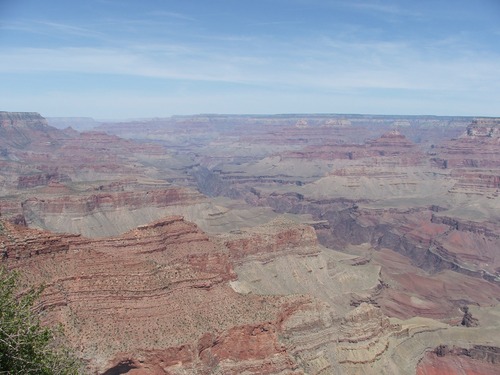
There were large numbers of Violet-green Swallows and White-throated Swifts flying about. These would be found at just about every park we visited. There were also some Brewer’s Blackbirds around.
After walking along the rim a little bit, the moment came that I had been hoping for. My wife, who had stepped away to get some pictures, saw it first, although I wouldn’t find that out until later. I just heard a guy say, “There’s an eagle”. I couldn’t see what he was referring to due to some vegetation in the way, but I had a strong suspicion that he was wrong. I hurried around so I could get a clean look and immediately saw the bird in flight. It was dark, and large. Very, very large. Binoculars revealed a dark head, and some white underneath the wings when it banked. Something else stood out – a wing tag. This was no mere eagle. Instead, it was the near-mythical California Condor. It didn’t stay in flight for nearly as long as I would have liked, instead it landed on a dead tree below us. Someone else then pointed out another bird perched on a nearby cliff. Both of these were subadults with black heads. Since they were perched on this side of the rim, we were able to get fairly good looks. There were a surprising number of people watching and photographing them, which was very encouraging.
These birds were released from captivity and thus not “countable” by listing rules. But I didn’t care one bit. I learned about the plight of these birds as a kid, before every wild bird had been captured. At the time, the prospect for the survival of the species appeared very dim, and the thought that I would ever see a free-flying bird never even entered my mind. Needless to say, this was a highlight of the trip for me.
Sunday, May 18 – Grand Canyon and Mesa Verde
We got up early this day to catch the sun rising over the canyon. Even though sunrise was around 5:20am, it seemed like 8:20 to us easterners, and thus not a big deal. As an unreformed late riser, this is one of the things I like best about birding in the west. After a few hours, we left the park via the west entrance, and stopped at every lookout point en route to appreciate the canyon some more. Some of the birds encountered this morning were Wilson’s Warbler, Ash-throated Flycatcher, Chipping Sparrow, Rock Wren, and the only Cactus Wren of the trip (heard only).
Along the way to Mesa Verde, we stopped at Four Corners, the only place in the US where four states (Utah, Colorado, New Mexico, and Arizona) meet. No birds to report here, but it was cool and definitely worth a stop if in the area.
After checking into our hotel in Cortez, CO, it was about 6pm. We had just enough time to drive the 10 minutes to Mesa Verde and hike some trails before sunset. Mesa Verde does not have many trails that you can hike without a permit. But one of them, the Prater Ridge Trail, was mentioned in the ABA’s Colorado guide as a good place to bird. We found it with no problems and started up the trail. We didn’t get very far, only a couple hundred yards until the trail splits. But that was a good thing, as the slow going was due to birds! One of the first birds encountered was an empidonax flycatcher. The most likely culprit here would be Dusky Flycatcher, which I was hoping for since it would be a lifer. Thankfully, the bird was calling often and singing portions of its song, revealing itself as a Dusky. I also got my best-ever look at a Green-tailed Towhee. This bird might have had a nest nearby, as it was making some weird calls, and even hopped right along the path in front of us. Another bird that put on a great show was a male MacGillivray’s Warbler. It responded quickly to pishing, and even perched for a little bit within arm’s length of me, right out in the open. Other birds seen and heard here include Hermit Thrush, Mountain Bluebird, Orange-crowned Warbler, Spotted Towhee, and Black-headed Grosbeak.
Monday, May 19 –Mesa Verde and Arches
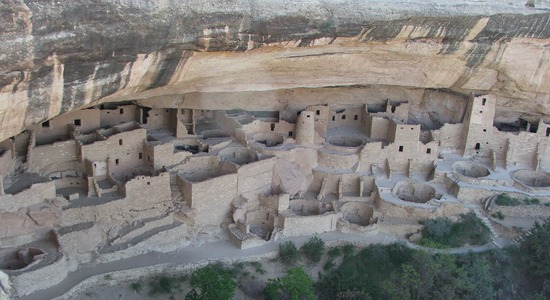
As nice as getting the lifer was, it wasn’t the main attraction at Mesa Verde. Like most visitors there, we had come to see the Anasazi ruins (or “Ancestral Puebloans” as they are known nowadays). We were at the visitor’s center when it opened in order to purchase tickets for the Cliff Palace tour. The Cliff Palace is one of several settlement sites here that were built in an alcove in the cliffs. It was an amazing tour, and very highly recommended. We didn’t have time to do the other tour that was offered of Balcony House. But we did walk a trail that ended at a nice overlook where you could see Balcony House set in the side of the cliff.
Birds seen today in Mesa Verde include Broad-tailed Hummingbird, Dusky Flycatcher (heard), Ash-throated Flycatcher, Black-billed Magpie, Bewick’s Wren, Black-throated Gray Warbler, Spotted Towhee, and Green-tailed Towhee. We also saw the only snake of the trip, a Great Basin Gopher Snake.
Mesa Verde is unusual among the national parks in that it was set aside for anthropological, rather than natural, features. In regard to geology and wildlife, it’s not very special. But walking among the ruins was amazing. The ranger leading our tour told us that the ground was shifting at the Cliff Palace, making it more unstable. In 10 years or so, they may not be able to allow tourists to visit it.
Around noon, we were on our way to Utah and Arches National Park. Before leaving Colorado I saw the only Loggerhead Shrike and Swainson’s Hawk of the trip.
Moab was our base of operations for this part of the trip. After checking in to the hotel, we went straight to the park. This place is just amazing; it looks like a storage facility for cool-looking geological features. It is the largest concentration of arches in the world, but there are all kinds of other interesting formations as well. We didn’t make it very far into the park, as we had to exit to find some dinner. But we came back in the evening to make the long, arduous hike to Delicate Arch. This is the signature feature of the park, and maybe even the entire region. Sunset is supposed to be the best time to see it, and is also the best time to make the 1.5 mile uphill hike (I would not want to do it during the heat of the day). As an added bonus, it was the night of a full moon, so we waited (along with dozens others) for the moon to rise behind the arch. It was a great way to end the day.
Not many birds to report from our brief time in Arches this day, but we did see some of the reintroduced Desert Bighorn sheep along the entrance road before the visitor’s center.
Tuesday, May 20 –Arches and Canyonlands
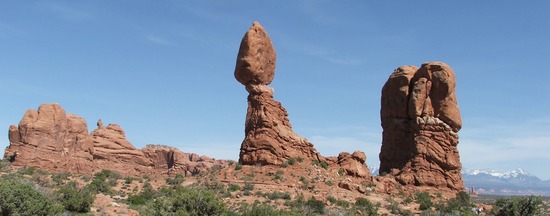
There was still plenty to see at Arches, so we started early this day with a hike to Landscape Arch. This arch, with a span of about 300 feet, is the largest known arch in the world. It’s an easy one mile hike to see it, and it is very worthwhile. As a bonus for me, the hike was relatively birdy. A Say’s Phoebe and male Mountain Bluebird were sallying from trees. Black-throated Sparrows and Rock Wrens hopped about. And a couple of Canyon Wrens serenaded us at the arch. But the best of all were four nondescript little brown birds. It was a great relief to finally see my life Juniper Titmouse.
Along with the condor, the bird I wanted to see most on this trip was the Gray Vireo. It has a fairly limited range, restricted to the Pinyon-Juniper woodlands of the southwestern states. I knew I had a very good shot at seeing one, since this habitat would be prevalent for most of our trip. But I was also apprehensive about missing it. Thus, I was really excited when I heard a vireo singing from some vegetation along the trail to Double Arch. I was even able to spot the bird, but I only had my binoculars with me, and it was too far away to see many details. But from what I could see, it looked right for Gray Vireo. Unfortunately, I was also within the range of the Plumbeous Vireo. These two look similar, but with a good view can easily be told apart. This, however, was not a good view. They also sound very much alike. The habitat was good for Gray, but probably marginal for Plumbeous. On the other hand, this was migration and birds can turn up anywhere. I believe that it was a Gray Vireo, but not comfortably enough to count it.
Arches was perhaps our favorite place on this trip. The plethora of arches was as amazing as we thought it would be. Delicate and Landscape Arches, especially, are not to be missed. But it was the other geological features that really surprised me – from the improbable Balanced Rock to the abrupt verticalness of the Courthouse Towers. The recent collapse of Wall Arch (one of the many that we did not see) is a testament to the impermanence of these structures. They may last for many more centuries, or may be gone tomorrow. Landscape, with the longest span of any known arch in the world, looks like a strong gust would bring it down. Like Mesa Verde, if you have any interest in this place, it would behoove you to visit sooner rather than later.
The next stop was the Islands in the Sky district of Canyonlands National Park. It was a cool place and had some great views, but overall it didn’t rank as highly with us as most of the other parks in our tour. But we didn’t have much time there, and we were not able to visit the other districts of this expansive park. There weren’t many birds active this afternoon, but did see a Hermit Thrush and the first House Finches of the trip. The latter was very surprising. Not that we saw it, but that it took us so long before we did. For a bird that is supposed to be a signature species of this region, we did not see very many of them on this trip.
Dead Horse State Park is next door to Canyonlands, and is supposed to have a view that rivals the Grand Canyon. My birdfinding guides also mention that you can find Gray Vireos there. We can affirm that the views are great, but would have been more impressive had we not already seen the Grand Canyon. As for the vireo, I don’t know. We didn’t get a chance to look due to threatening rain and wind gusts that could knock you backwards. It was probably for the best, though, because we had a long drive ahead of us to Torrey, just outside Capitol Reef.
The views from these two parks were indeed amazing. However, they pale in comparison with the Grand Canyon. It would have been nice to see more of Canyonlands, especially the Needles district. But we just didn’t have enough time, which was a recurring theme on this trip.
Wednesday, May 21 – Capitol Reef and Bryce Canyon
Capitol Reef is a small, little known national park. There doesn’t seem to be as much to do there as there is at other nearby parks. And due to circumstances to be described shortly, we weren’t able to do as much as we would have liked here, which definitely did not help our perception of the park.
My main target here was the Chukar, an introduced game bird. On a previous trip to Colorado, I spent a good deal of effort trying to find one to no avail. The guidebooks indicated that it should be easy to find these birds along the scenic drive between the visitor’s center and campground. Ha! If they were around, they certainly didn’t want to be found. We walked from the picnic area to the visitor’s center and back, but there wasn’t a sign of these wily birds. But we were compensated with a gorgeous male Bullock’s Oriole, along with Western Tanager, Black-headed Grosbeak, Western Kingbird, Lesser Goldfinches, and others. I also got a brief look at a Golden Eagle flying down the gorge. We also saw several mammal species – Mule Deer, a chipmunk of some kind, Rock Squirrel (common everywhere we went), White-tailed Antelope Squirrel, and Yellow-bellied Marmot.
After getting back to the car, we drove down the scenic drive until it turned into a dirt road. We didn’t continue because of the signs warning about potential flash floods when it rains, and the skies indicated rain was a distinct possibility. The day started very pleasant, with just a little chill and breeze. By the time we got back to the visitor’s center, it was cloudy, drizzling, very gusty, and cold (in the 40’s). We were able to see the nearby petroglyphs, but not much else. The weather also forced us to forgo any further attempts to find the Chukars.
We left Torrey on Highway 12, heading toward Bryce Canyon. This road is one of, if not the, most scenic roads in the country. It starts by going over a national forest covered mountain, and then proceeds through the Escalante-Grand Staircase National Monument.
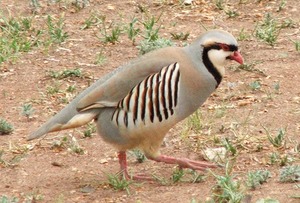
We were making good time, and thus were able to stop at Escalante Petrified Forest State Park. My birding guides said that Chukars could be found around the campground there. We quickly found a Yellow Warbler, Western Scrub-jay, and some others. Getting a little frustrated at the apparent lack of Chukars, I headed toward the boat launch to see if there were any interesting birds on the small lake. It was then that my wife asked, “What’s that?” I followed her gaze to a picnic table 15 feet to my left. Standing on top of the table, pretty-as-you-please, was a Chukar. It seemed so surreal that I doubt I would have noticed it on my own! It soon jumped down and then started foraging with another one that had been hidden. Paintings, and even photographs, of this species do not do it justice. It has a striking, yet understated, beauty.
After getting my fill, I finally continued down to the water. On the lake were Western and Eared Grebes, Mallards, Redhead, and American Coots. Along the shore were a couple Spotted Sandpipers and Black-necked Stilts.
Continuing on, we arrived at Bryce Canyon around 5:00. We had enough daylight to see the sights along the drive, but not to do any hiking. Unfortunately, it was overcast and cold (40’s, and even into the 30’s at the higher elevations with some snow flurries). But we were at least able to see the incredible sights here, which was important because the forecast for the next day was more of the same.
Thursday, May 22 – Bryce Canyon and Zion
This morning was supposed to see temperatures in the 30’s and some snow. So we slept in a bit! We returned to the park around 9, and it wasn’t too bad. It was cold and overcast, but no snow. The first thing we did was look for the reintroduced, endemic Utah Prairie Dog. We found some mounds in a field yesterday, but no dogs. When we returned to that field, we quickly saw three of the animals running around and foraging. We watched and photographed them from the car for a couple of minutes, and then went back to Sunset Point.
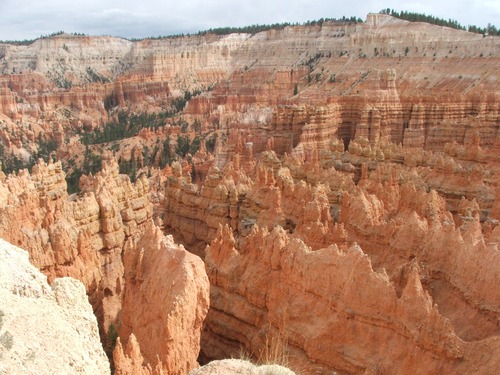
We had to take the trail down into the Bryce Canyon Amphitheater, regardless of the weather. The chance to walk down amongst the incredible hoodoo formations couldn’t be passed up. It turned out just fine, with the coolness keeping us from getting too hot on the climb back up. We went down the Navajo Trail, and then came back up the Queen’s Garden Trail, which was supposed to be the easiest route according to the guidebook. It is a very cool hike, and highly recommended. I didn’t see many birds on this hike, but three of them – Townsend’s Solitaire, Pygmy Nuthatch, and Steller’s Jay – we wouldn’t see anywhere else on the trip. Also seen in the park were Wild Turkey, Red-tailed Hawk, Broad-tailed Hummingbird, White-breasted Nuthatch, Mountain Chickadee, Common Raven, Western Bluebird, Spotted Towhee, and Lesser Goldfinch. Also, watch for Pronghorn among the trees between the park’s sign and the entrance station.
Bryce Canyon itself was simply spectacular. Photographs of the weird hoodoo formations do not do them justice. I would highly recommend driving the length of the scenic drive, stopping at each of the points of interest. And if you’re able to, the various paths down into the amphitheater are very interesting. Even though this is a very small park, relatively speaking, we were surprised that it ended up one of our favorites.
Leaving the Bryce area, I found a thrasher singing from a wire when I turned onto a road so I could turn around. I figured it was a Sage, and since I didn’t realize at the time that Bendire’s was a distant possibility, I didn’t attempt a definitive look. My bad. Other than that, it was an uneventful drive to Zion. We came into Zion via the east entrance, which meant that we got to drive through the long, narrow Zion-Mt. Carmel Tunnel, built in the 1930’s. While we were waiting our turn to enter, another motorist pointed out some nearby Bighorn.
We made it to the visitor’s center around 5:00. We had the entire next day in the park, so we waited to take the shuttle into the main canyon. Instead, we walked the Pa’rus Trail north from the visitor’s center. This was probably the birdiest area on the entire trip, especially around the campground. Western Tanagers were everywhere! I was also excited to find a male Lucy’s Warbler singing on some bare snags along the trail. My only previous look at this species had been extremely poor, so I welcomed the chance to study this one at-length.
Twice I heard a vireo singing. Again, it could be either a Gray or Plumbeous. One that I finally tracked down and got a good look at turned out to be the latter. There were many empidonax flycatchers along the river, but they were silent, which means that they remained unidentified. The new birds for the trip included Warbling Vireo, a male Summer Tanager, Yellow-breasted Chat (heard only), and a pair of Lazuli Buntings.
Friday, May 23 – Zion
Time was running out on my quest to find the Gray Vireo. Therefore, we started the day with a drive up Kolob Terrace Road. This road eventually ascends to Kolob Reservoir, and passes in and out of Zion. But the area I was interested in was the section of Pinyon-Juniper habitat that it passes through. My plan was simply to drive with the windows down and listen for vireos, and then hope I can find them. I first heard a likely candidate just before the first time the road enters the national park. It sounded pretty distant, so I played the vireo’s song a few times. I didn’t get any response, and never spotted any movement. (Note: I believe that all playback is prohibited in the national parks, thus I only did it this one time, when I knew I was outside the park boundary.) I hadn’t heard anything else by the time the road left the likely-looking habitat, so I turned around. I didn’t hear anything on the way down, either. The majority of the habitat looked like it had been burned recently, so I didn’t know if that affected the vireo population. On the positive side, I did see two Lark Sparrows, and many Western Tanagers.
Failing to find the vireo, we proceeded to the main section of Zion, where we did most of the short, easy trails. The Riverwalk Trail was the most productive, and even provided my life Cordilleran Flycatcher. I heard it first, and finally spotted it calling from a bare snag. A Black Phoebe was cool to see, but the most entertaining was a family of American Dippers. There were two adults, and one of them was actively feeding a fledgling. I’ve seen dippers several times before, but had never seen them foraging underwater. Thus, I was excited to see the adult engage in its unique foraging behavior. It would disappear underwater in the fast moving river and then pop back up and feed something to its progeny. It didn’t seem to need much time to find food, as it usually stayed underwater for only a couple of seconds.
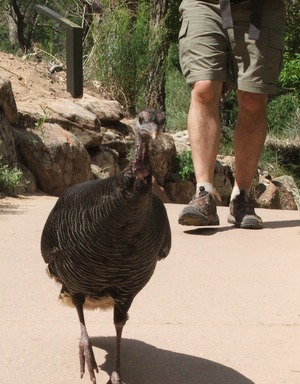
Yellow Warblers were abundant throughout the park, and we also saw several Wild Turkeys. One of them, obviously used to tourists, walked within arm’s length of us along one of the trails.
After a much needed ice cream break, we returned to Kolob Terrace Road to try again for the vireo. Even though we started after 5:00, there were a few more birds around this time: Western Kingbirds, Western Wood-pewee (heard only), Juniper Titmouse, Western Scrub-jay, Black-throated Gray Warbler, and Black-headed Grosbeaks. Western Tanagers were again everywhere. But no vireos were heard on the way up. Frustrated, I turned around and started back. Again, nothing was heard on the way down. As a last ditch effort, I stopped just outside the sign for Zion where I though I had heard some vireos earlier in the day. Amazed, I heard them again! I walked forward so that I could look down into the valley, and actually spotted some movement near the bottom, in the bottom of some trees. With binoculars, I saw two birds that looked good for Gray Vireo, but again I was too far away to be comfortable with the ID. But this time I had the scope ready in the back seat of the car. The birds were extremely cooperative and allowed great scope views, confirming that they were, in fact, Gray Vireos. Yes!!! That may be one drab, little bird, but it was one of my most satisfying lifers.
Precaution to anyone birding on Kolob Terrace Road: watch out for speeding vehicles. I don’t know if it was because it was the afternoon, or a Friday afternoon, or the Friday afternoon before a holiday weekend, but there were many trucks (mostly pulling ATV’s) speeding up this road. It made it difficult to listen, and especially to stop, for birds. We didn’t have this problem during the morning’s trip.
Saturday, May 24 – Zion and Las Vegas
We started this day at the Kolob Canyon section of Zion, but the weather was awful – cold and foggy. We just drove the scenic drive and got out at a couple of stops. The only birds seen were Western Scrub-jay, Spotted Towhee, and Black-headed Grosbeak.
Zion has many features, and in our short time here, we only scratched the surface. The geological features aren’t as striking as most of the other parks, but the varied terrain and mix of habitats means that there should be more birds. Indeed, we saw many more birds here than any of the other parks.
We then made the long drive to our final destination, Las Vegas. Not many birds to report from there, naturally, but surprisingly we saw the only Northern Mockingbird of the trip while driving through the city.
Summary
The diversity of birds seen on this trip was not great, only 88 species. Of those, five were lifers for me. But this area would be worth visiting even if there were zero birds! These parks are spectacular, and despite their geographic proximity, it was amazing how different each one was. Each deserved much more time than we had to give. Surprisingly though, we were still able to do most of what we really wanted to do.
Species List
- Eared Grebe
- Western Grebe
- Double-crested Cormorant
- Canada Goose
- Mallard
- Redhead
- Turkey Vulture
- California Condor
- Swainson’s Hawk
- Red-tailed Hawk
- Golden Eagle
- American Kestrel
- Wild Turkey
- Chukar
- American Coot
- Black-necked Stilt
- Spotted Sandpiper
- Rock Pigeon
- Eurasian Collared-dove
- Mourning Dove
- White-throated Swift
- Broad-tailed Hummingbird
- Northern Flicker
- Western Wood-pewee
- Dusky Flycatcher
- Cordilleran Flycatcher
- Black Phoebe
- Say’s Phoebe
- Ash-throated Flycatcher
- Western Kingbird
- Violet-green Swallow
- Northern Rough-winged Swallow
- Barn Swallow
- American Dipper
- Cactus Wren
- Rock Wren
- Canyon Wren
- Bewick’s Wren
- House Wren
- Northern Mockingbird
- Western Bluebird
- Mountain Bluebird
- Townsend’s Solitaire
- Hermit Thrush
- American Robin
- Blue-gray Gnatcatcher
- Mountain Chickadee
- Juniper Titmouse
- Pygmy Nuthatch
- White-breasted Nuthatch
- Loggerhead Shrike
- Steller’s Jay
- Western Scrub-jay
- Black-billed Magpie
- American Crow
- Common Raven
- European Starling
- House Sparrow
- Gray Vireo
- Plumbeous Vireo
- Warbling Vireo
- House Finch
- Lesser Goldfinch
- Orange-crowned Warbler
- Lucy’s Warbler
- Yellow Warbler
- Yellow-rumped Warbler
- Black-throated Gray Warbler
- MacGillivray’s Warbler
- Wilson’s Warbler
- Yellow-breasted Chat
- Summer Tanager
- Western Tanager
- Green-tailed Towhee
- Spotted Towhee
- Chipping Sparrow
- Lark Sparrow
- Black-throated Sparrow
- Song Sparrow
- Dark-eyed Junco
- Black-headed Grosbeak
- Lazuli Bunting
- Red-winged Blackbird
- Western Meadowlark
- Brewer’s Blackbird
- Great-tailed Grackle
- Brown-headed Cowbird
- Bullock’s Oriole
Posted by Grant McCreary on November 10th, 2009.





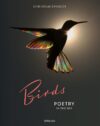
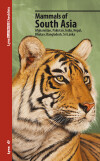
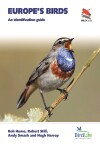
Sounds like an amazing trip. Your condor story reminded me of my trip to Vegas in 2004. We took a bus trip to the west rim of the Grand Canyon. The very boisterous driver shouted, “There’s a California Condor!” It was a darn Turkey Vulture. I didn’t have the heart to spoil it for the people on the bus.
LOL
Wow, talk about dashed hopes
Great report trip and a very good itinerary for trips done with the non-birding spouse. Congrats on finally getting the Gray Vireo! I was relieved and pleased that you finally did get tickable views. Your experiences with this dainty ghost of the canyonlands reminded me of the trials and tribulations I had with this bird while working in Colorado. I saw plenty of Plumbeous Vireos, but it wasn’t until birding at the Hovenweep Ruins that I finally saw my lifer (and only) Grays.
Thanks, Pat!
I was so relieved and happy to get those Grays. I have to admit that I got pretty lucky. I put in a good bit of time looking and listening for them, but it could’ve taken much longer, and I just didn’t have much more time to look for them given our busy schedule. Glad to hear that it worked out for you, too!
If you visit the Grand Canyon again – you should go to the north rim. It is less visited and the california condor is easily seen. The vermillian cliffs is only miles from the entrance of the north rim of grand canyon where the birds nest. The california condor has the biggest wingspan of any bird in north america. They are such a beautiful bird to see.